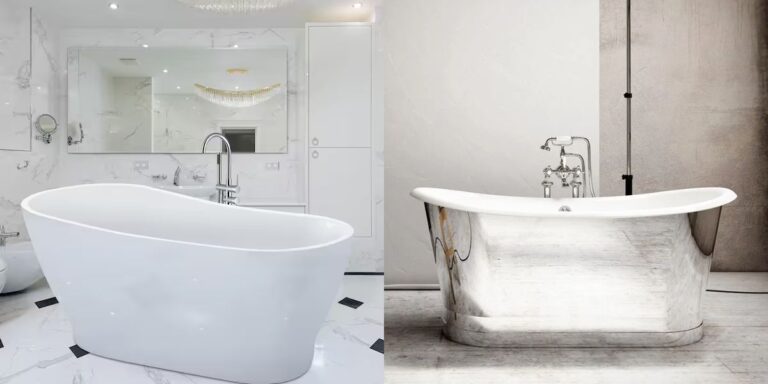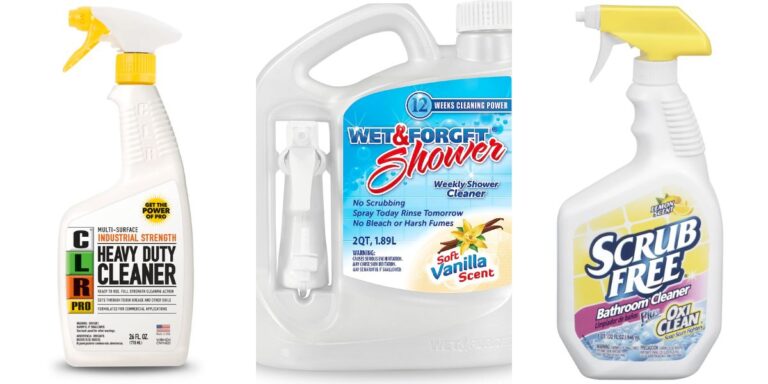How to Make a Straight Back Tub Comfortable?
Standard tubs without curved backs can really dig into your spine and cause muscle aches if you’re not strategic about cushioning and posture. Through trial and error with different cushions and bath accessories, I’ve found some simple ways to turn my cold, hard tub into a soothing oasis.
How to Make a Straight Back Tub Comfortable?
For back relief in a hard tub, carefully place cushions behind your lower back, under legs, and behind your neck. Keep water temp warm but not too hot, around 98 degrees. Add Epsom salts or oils for muscle relaxation. Sit upright with proper posture and take breaks to avoid overheating.
Choose the Right Cushions and Pillows
Cushions and pillows are absolutely essential for adding comfort to a straight-back tub. The hard surface just won’t cut it on its own. But you have to choose cushions carefully based on material and shape. Below are the best bath pillows for straight-back tubs for you:
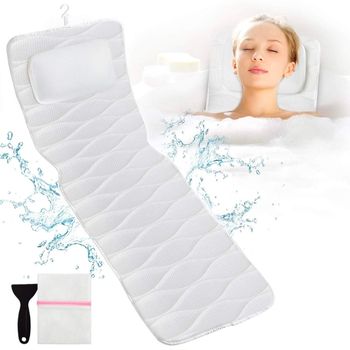
Full Body Bath Pillow, with Mesh Washing Bag
Best Pillow for Head Neck Shoulder and Back Support
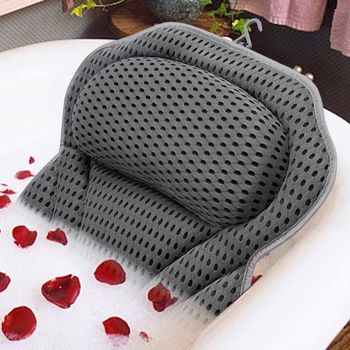
Luxury Bathtub Pillow Bath Pillows
Best with Non-Slip Suction Cups

AEROiVi Full Body Bath Pillow with Lumbar Pillow
Best Pillow with Lumbar
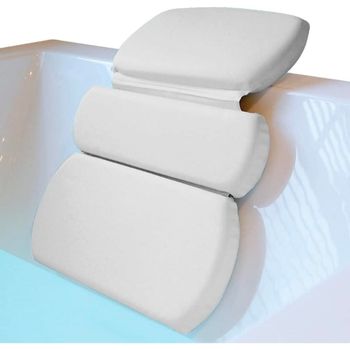
Gorilla Grip Bath Pillow for Tub
Best Selling Pillow
What kind of cushions work best for a straight back tub?
In my experience, foam, inflatable, and waterproof cushions tend to work best for making hard tub surfaces more comfortable. Look for cushions specifically designed for tubs and baths, not just standard foam pillows. The material needs to stand up to moisture without getting moldy.
I’d steer clear of bean bag-style cushions filled with polystyrene beads. They absorb too much water and get lumpy. Trust me, once I tried a bean bag cushion in the tub and regretted it quickly. I’ve also found memory foam can be too rigid for the tub since it fully takes the shape of the surface. You want a little squish and give.
Where should you place cushions in a straight back tub?
Strategic cushion placement is key for maximizing back support in a straight tub. Definitely put one cushion directly behind your lower back as you recline slightly. You can adjust the angle and height depending on your tub shape. I also recommend placing a cushion under your legs, either under the calves or behind the knees. This takes pressure off your back.
If you need extra head and neck support, a small inflatable pillow or rolled towel behind your neck does the trick. Just don’t overdo it on cushions to the point you feel crowded. Space them out for optimal alignment. I made that mistake initially, cramming in too many cushions until I was overwhelmed.
Tips for keeping cushions in place
You want cushions that stay put, rather than constantly floating around the tub. That can get annoying fast. Look for cushions with suction cups on the bottom that stick to the tub surface. This keeps them stable as you move. Some inflatable pillows also have textured bottoms that help grip the tub.
I’ve also had success using a non-slip mat or shelf liner under cushions to keep them from sliding. The rubbery grip helps anchor them. Just trim the mats to fit the cushions.
Adjust the Water Temperature
Dialing in the perfect warm but not scalding hot water temp is imperative for a truly relaxing bath. The right temperature helps your muscles completely unwind.
What water temperature is optimal for relaxation?
According to bath experts and my personal testing, the ideal temperature for a soothing, muscle-melting bath is about 92-100°F. Any hotter than 100 and you risk overheating. I made that mistake once and jumped out within 5 minutes, feeling woozy.
Cooler water temperatures under 90 degrees may actually make your muscles tense up rather than relax. Our muscles naturally loosen in warmer water since it emulates body temperature. I found the sweet spot for me is around 98 degrees.
Should you add bath salts, oils or bubbles?
Absolutely! Bath accessories like Epsom salts, essential oils, and mineral bubbles can enhance the muscle-relaxing benefits of a warm tub. The right bath products also create a spa-like atmosphere.
I like to alternate between bath salts and essential oils like eucalyptus and lavender. The eucalyptus especially opens up my sinuses. For sore muscles, Epsom salts work wonders since they contain magnesium. Don’t be shy about pouring in a generous amount. Bubbles add mood-boosting aroma and make me feel like I’m at a fancy spa.
How to avoid getting overheated
As relaxing as a warm bath can be, it’s easy to overdo it and get dizzy or nauseous. Be sure to take breaks from the tub if you notice yourself getting overheated. Sit up, drape a cold rag over your forehead and neck, and drink some cool water.
I also suggest keeping a window cracked or a bathroom door open to let in fresh air. Have a timer or alarm handy to remind you to take a break every 15 minutes or so. Staying too long in an overheated environment can be dangerous.
Practice Good Posture
To maximize back comfort in a straight tub, pay attention to your seated posture. Slouching or straining your neck can negate the benefits.
What seated position works best?
The ideal position is sitting upright with your back naturally aligned against the tub and cushions. Avoid any hunching forward or arching the spine too far back.
Maintaining good posture distributes your weight evenly and takes pressure off your lower back. Supportive cushions behind your back allow you to sit up straight without getting sore.
You can recline slightly, just don’t lay flat on your back for long periods. Reclining 10-15 degrees helps open your chest muscles.
Should you recline in the tub at all?
Yes, a slight recline can be therapeutic as long as you have cushions behind your back. Don’t lay entirely flat unless you have a pillow under your legs too. Fully reclining flat on the hard surface puts strain on your spine.
I like to ease back just a little against my tub pillow. But I’m careful not to slide down too far or let my lower back arch up off the cushion. The key is spine alignment and even weight distribution.
Tips for proper head and neck support
Don’t forget about cushioning your head and neck area. The tub edge can really jab you if you lay back directly on the hard surface.
I suggest using a small inflatable pillow or rolled towel behind your neck for support. Position it to keep your neck elongated and avoid crunching your chin down toward your chest. Proper head positioning takes pressure off the upper back as well.
Relax with Some Soothing Music or Aromatherapy
This may seem obvious, but turning on some calming music or aromatherapy during a bath can help your mind relax as much as your muscles. I like instrumental spa music at low volume. For aromatherapy, a few drops of lavender oil is soothing.
Grab a Good Book or Magazine
Having reading material handy ensures I actually sit back and relax, rather than just soaking for 2 minutes and jumping out. It also gives your mind something to focus on besides work stress. Some bath time with a trashy novel is self-care at its finest!
Take It Easy Getting In and Out
This sounds silly, but be cautious easing yourself in and out of a slippery tub, especially if you have back issues. Move slowly and use grab bars if needed. Sit first, then swing legs in. To get out, roll to your side and push up with your arms. Avoid any jerking or twisting motions.
Invest in a Cushioned Bath Mat
Step out of the tub onto cushy bliss! A soft, absorbent bath mat feels wonderful on post-bath feet. It also prevents slips on the hard tile. Look for a mat with memory foam or gel infusion.
Stay Hydrated with a Refreshing Drink
Don’t forget to hydrate! Have an electrolyte drink or water handy to replace fluids. I also love sipping a mug of herbal tea while I soak. Peppermint tea helps refresh and reenergize.
Give Yourself Time to Transition Afterward
Instead of popping right up out of the tub, take 5-10 minutes to transition slowly. Sit on the tub edge, sip your drink, dry off leisurely. Avoid rushing into getting dressed or chores. Let the relaxation soak in (pun intended).
Add Epson Salt for Sore Muscles
If muscle soreness is your main concern, be sure to add a generous amount of Epsom salt to your bath water. The magnesium in the salts helps relax muscle tension. For severe soreness, mix the salts with hot water first to dissolve them fully before adding to the tub.
Dim the Lights for Total Relaxation
Set the mood with calm, dim lighting. I turn off the harsh overhead light and use a small lamp or candle instead. Soft lighting helps relax your eyes as well as your body. Play around with different calming colors too. I like light blue or lavender.
Spread Out the Cushions
Rather than cramming all your cushions together in one spot, spread them out for optimal alignment. Put one behind your lower back, another under your calves, and a neck pillow up higher. Space gives you more mobility. Don’t make it so crowded you feel immobilized.
Add Cold Towel and Cool Drink For Overheating Prevention
If you start feeling lightheaded or overheated in the warm bath, drape a cold rag over your forehead and take a few sips of cool water or electrolytes. This helps stabilize your temperature. Keep both within arm’s reach for quick relief.
Invest in Quality Cushions for the Long Term
It’s worth spending a little more on cushions made of durable, mold-resistant materials. The cheap foam pillows degrade quickly. Prioritize cushions made for baths and hot tubs – they last longer. This prevents having to replace them every month when they get grungy.
Try Different Cushion Materials Like Foam, Inflatable, and Waterproof
I recommend experimenting with cushions made of different materials like foam, inflatable, and waterproof vinyl to see what feels best. Everyone has unique pressure points and padding preferences. Don’t be afraid to mix and match – use an inflatable neck pillow with a foam back cushion, for example. Finding your ideal cushion combination takes some trial and error.
Add Bath Oil for Moisturizing
Looking for ultra-smooth, hydrated skin? Add a capful of bath oil, like sweet almond or olive oil, to the warm water. The oil moisturizes the skin as you soak. Just don’t add too much, or the tub may get slippery. Follow with a rich lotion after toweling off.
Keep Arms Relaxed at Your Side
Proper arm placement takes the pressure off your shoulders and neck. Rest your arms gently on the tub ledge, loose and relaxed. Avoid tensing your arms or raising them over your head for long periods. Think calm, loose, and floating.
Tub too Slippery? Add Non-Slip Treads
If your tub floor feels dangerously slick even when dry, apply non-slip treads to the bottom. These adhesive strips add traction so you can get in and out more securely. Apply them carefully in a criss-cross or checkerboard pattern for optimal grip. Just wash gently to keep the adhesive intact.
Adjust Water Temperature Throughout Session
Don’t just set the water temp once and leave it be. Your body temp fluctuates as you soak, so fiddle with the hot and cold taps to stay comfortable. I’ll often run a little hotter water if I feel chilly or add cold if I’m overheating. Check-in with your body.
Exfoliate Beforehand to Enhance Circulation
Gently exfoliating with a scrub or loofah before a soak improves circulation. It whisks away dead skin cells and allows the warm water to better penetrate. Focus on rough elbows, knees, and heels. But don’t scrub hard enough to leave your skin raw. Rinse away all traces of scrub.
Rotate Between Hot Tub and Bath
If you also have access to a hot tub, alternate time between the hot, jetted water and the still, warmer bath. The hot tub’s jets target sore muscles, while the bath promotes relaxation. The contrast feels incredible. Just be sure to fully rinse off between soaking in the different waters.
Moisturize Afterward While Skin is Hydrated
Lock in that post-bath hydration by applying body lotion or cream once toweled off. Hydrated skin absorbs moisture better than dry skin. Apply lotion to damp skin and massage in gently. Focus on cracked heels, elbows, and any dry patches.
Stretch Out Sore Muscles Afterward
Don’t just plop down on the couch after a bath – take time to stretch tight muscles first. Even simple twists, hamstring and calf stretches increase flexibility. Yoga poses like child’s pose open the hips and back. Stretching while muscles are warm enhances release.
Schedule Baths as a Regular Self-Care Ritual
Rather than just taking a spontaneous bath when you think of it, schedule soak sessions regularly. Mark it on your calendar like any other appointment. Knowing it’s coming forces you to actually carve out time for relaxation. I aim for three leisurely baths per week, either at night or during the weekend.
Clean the Tub First
This may seem obvious, but thoroughly cleaning and disinfecting the tub before drawing your bath is a must! Scrub away any grime or mildew so you can truly relax in fresh water. Tidy up bath accessories like salts and razors too. Light an invigorating shower gel candle while cleaning to set the mood.
Add Essential Oils to the Tub Edge
Rather than add essential oils directly to your bath water, place a few drops along the edge of the tub before you get in. This still releases the aroma as steam rises. The benefit – your skin doesn’t directly absorb the concentrated oil, which can cause irritation. Don’t forget to clean oil residue off the tub after.
Frequently Asked Questions
What’s the best cushion material for a hard tub?
For cushions that work best in a hard tub, I’d say go with foam, inflatable vinyl, or waterproof fabrics actually made for bath time. Steer clear of bean bags or memory foam – they just don’t cut it with all that moisture.
Where should you place cushions in a straight tub?
Cushion placement is key! You’ll want support behind your lower back, under your legs, and a pillow behind your neck. But don’t cram in too many or you’ll feel trapped. Space them out for comfy support.
What’s the ideal water temperature for muscle relaxation?
In my experience, the ideal temp for muscle melting is 92-100°F. Any cooler and your body tenses up. Hotter than 100 and you risk dizzy spells. I aim for 98 – perfect for relaxation!
How can you avoid getting dizzy in a hot bath?
If you start feeling lightheaded in a steamy bath, sit up and put a cool rag on your forehead, stat! Keeping a window open and setting a timer helps too so you remember to take breaks.
What kind of bath accessories enhance relaxation?
For next level relaxation, I highly recommend bath accessories like Epsom salts, eucalyptus or lavender oil, and fizzy bubbles. Not only do they smell amazing, they really help soothe sore muscles.
See more:

William J. Bullock is a licensed plumber with over 15 years of experience installing and repairing bathtubs. He runs his own plumbing company in Greenville and serves residential and commercial clients. William is dedicated to providing honest, transparent advice to help homeowners make informed decisions about their bathroom renovations.
He has established expertise in selecting bathtubs, planning custom installations, diagnosing issues, and completing repairs. William aims to share practical tips and reliable recommendations based on extensive hands-on work. When he isn’t on a job site, William enjoys spending time with his family and volunteering at local community events. He takes pride in delivering quality service and enjoys helping people upgrade their homes.




